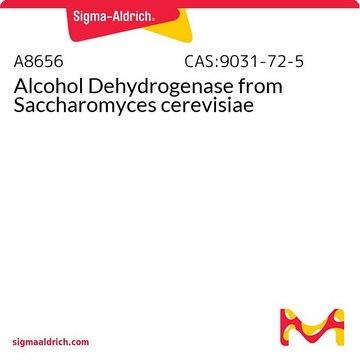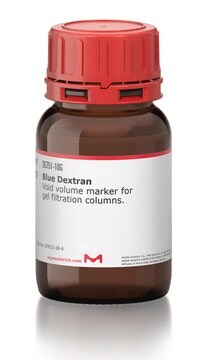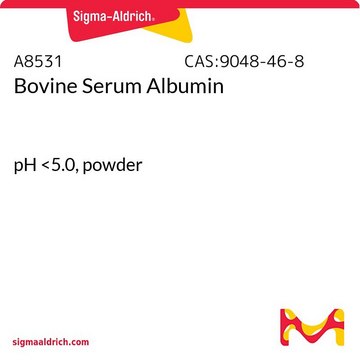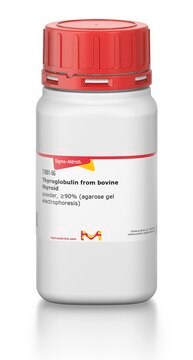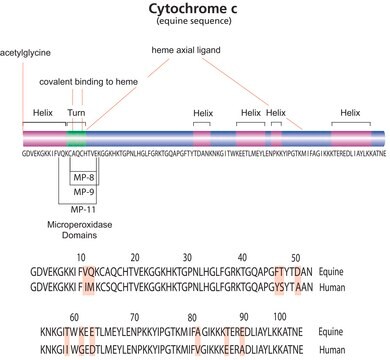MWGF1000
Gel Filtration Markers Kit for Protein Molecular Weights 29,000-700,000 Da
Synonym(s):
Gel Filtration Markers Kit, Gel Filtration Protein Ladder, Protein Molecular Weight Marker Kit
About This Item
Recommended Products
General description
Application
- for protein purification and analyses (gel-filtration experiments)
- for size-exclusion chromatography/gel filtration chromatography of synaptoneurosome extract
- for glycerol gradient centrifugation
- to study glucocorticoid-induced lymphocytolysis as a model system for apoptosis within the immune system
- to isolate Polygonatum odoratum lectin, which showed remarkable anti-HSV-II activity towards Vero cells, cytotoxicity towards human melanoma A375 cells and induced apoptosis in a caspase-dependent manner
Biochem/physiol Actions
Other Notes
- For research use only. Not for drug, household, or other uses.
- Please consult the Safety Data Sheet for information regarding hazards and safe handling practices.
- Please refer to the product information sheet to learn more about reagents, storage and stability, and procedure.
Kit Components Also Available Separately
- A8531Albumin, bovine serum, 66,000 MW 1 mL/vialSDS
- A8656Alcohol Dehydrogenase, yeast, 150,000 MW 1 mL/vialSDS
- A8781 β-Amylase, sweet potato, 200,000 MW 1 mL/vialSDS
- A3660 Apoferritin, horse spleen, 443,000 MW 1 mL/vialSDS
- D4772Blue dextran, 2,000,000 MW 1 mL/vialSDS
- C7025Carbonic Anhydrase, bovine erythrocytes, 29,000 MW 1 mL/vialSDS
- T9145Thyroglobulin, bovine, 669,000 MW 1 mL/vialSDS
Signal Word
Danger
Hazard Statements
Precautionary Statements
Hazard Classifications
Resp. Sens. 1
Storage Class Code
10 - Combustible liquids
Flash Point(F)
Not applicable
Flash Point(C)
Not applicable
Regulatory Listings
Regulatory Listings are mainly provided for chemical products. Only limited information can be provided here for non-chemical products. No entry means none of the components are listed. It is the user’s obligation to ensure the safe and legal use of the product.
PDSCL
Please refer to KIT Component information
PRTR
Please refer to KIT Component information
FSL
Please refer to KIT Component information
ISHL Indicated Name
Please refer to KIT Component information
ISHL Notified Names
Please refer to KIT Component information
Cartagena Act
Please refer to KIT Component information
JAN Code
キットコンポーネントの情報を参照してください
Certificates of Analysis (COA)
Search for Certificates of Analysis (COA) by entering the products Lot/Batch Number. Lot and Batch Numbers can be found on a product’s label following the words ‘Lot’ or ‘Batch’.
Already Own This Product?
Find documentation for the products that you have recently purchased in the Document Library.
Customers Also Viewed
Our team of scientists has experience in all areas of research including Life Science, Material Science, Chemical Synthesis, Chromatography, Analytical and many others.
Contact Technical Service





